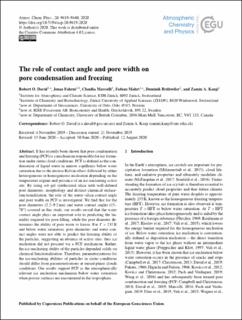Please use this identifier to cite or link to this item:
https://doi.org/10.21256/zhaw-20353Full metadata record
| DC Field | Value | Language |
|---|---|---|
| dc.contributor.author | David, Robert O. | - |
| dc.contributor.author | Fahrni, Jonas | - |
| dc.contributor.author | Marcolli, Claudia | - |
| dc.contributor.author | Mahrt, Fabian | - |
| dc.contributor.author | Brühwiler, Dominik | - |
| dc.contributor.author | Kanji, Zamin A. | - |
| dc.date.accessioned | 2020-08-17T08:29:44Z | - |
| dc.date.available | 2020-08-17T08:29:44Z | - |
| dc.date.issued | 2020-08-12 | - |
| dc.identifier.issn | 1680-7316 | de_CH |
| dc.identifier.issn | 1680-7324 | de_CH |
| dc.identifier.uri | https://digitalcollection.zhaw.ch/handle/11475/20353 | - |
| dc.description.abstract | It has recently been shown that pore condensation and freezing (PCF) is a mechanism responsible for ice formation under cirrus cloud conditions. PCF is defined as the condensation of liquid water in narrow capillaries below water saturation due to the inverse Kelvin effect, followed by either heterogeneous or homogeneous nucleation depending on the temperature regime and presence of an ice-nucleating active site. By using sol–gel synthesized silica with well-defined pore diameters, morphology and distinct chemical surface-functionalization, the role of the water–silica contact angle and pore width on PCF is investigated. We find that for the pore diameters (2.2–9.2 nm) and water contact angles (15–78°) covered in this study, our results reveal that the water contact angle plays an important role in predicting the humidity required for pore filling, while the pore diameter determines the ability of pore water to freeze. For T>235 K and below water saturation, pore diameters and water contact angles were not able to predict the freezing ability of the particles, suggesting an absence of active sites; thus ice nucleation did not proceed via a PCF mechanism. Rather, the ice-nucleating ability of the particles depended solely on chemical functionalization. Therefore, parameterizations for the ice-nucleating abilities of particles in cirrus conditions should differ from parameterizations at mixed-phase clouds conditions. Our results support PCF as the atmospherically relevant ice nucleation mechanism below water saturation when porous surfaces are encountered in the troposphere. | de_CH |
| dc.language.iso | en | de_CH |
| dc.publisher | Copernicus | de_CH |
| dc.relation.ispartof | Atmospheric Chemistry and Physics | de_CH |
| dc.rights | https://creativecommons.org/licenses/by/4.0/ | de_CH |
| dc.subject.ddc | 551: Geologie und Hydrologie | de_CH |
| dc.title | The role of contact angle and pore width on pore condensation and freezing | de_CH |
| dc.type | Beitrag in wissenschaftlicher Zeitschrift | de_CH |
| dcterms.type | Text | de_CH |
| zhaw.departement | Life Sciences und Facility Management | de_CH |
| zhaw.organisationalunit | Institut für Chemie und Biotechnologie (ICBT) | de_CH |
| dc.identifier.doi | 10.5194/acp-20-9419-2020 | de_CH |
| dc.identifier.doi | 10.21256/zhaw-20353 | - |
| zhaw.funding.eu | No | de_CH |
| zhaw.issue | 15 | de_CH |
| zhaw.originated.zhaw | Yes | de_CH |
| zhaw.pages.end | 9440 | de_CH |
| zhaw.pages.start | 9419 | de_CH |
| zhaw.publication.status | publishedVersion | de_CH |
| zhaw.volume | 20 | de_CH |
| zhaw.publication.review | Open peer review | de_CH |
| zhaw.funding.snf | 156581 | de_CH |
| zhaw.webfeed | Polymerchemie | de_CH |
| zhaw.funding.zhaw | Untersuchung der Eisbildungsmechanismen in der Atmosphäre | de_CH |
| zhaw.author.additional | No | de_CH |
| zhaw.display.portrait | Yes | de_CH |
| Appears in collections: | Publikationen Life Sciences und Facility Management | |
Files in This Item:
| File | Description | Size | Format | |
|---|---|---|---|---|
| 2020_David_etal_Contact-angle-and-pore-width_ACP.pdf | 5.68 MB | Adobe PDF |  View/Open |
Show simple item record
David, R. O., Fahrni, J., Marcolli, C., Mahrt, F., Brühwiler, D., & Kanji, Z. A. (2020). The role of contact angle and pore width on pore condensation and freezing. Atmospheric Chemistry and Physics, 20(15), 9419–9440. https://doi.org/10.5194/acp-20-9419-2020
David, R.O. et al. (2020) ‘The role of contact angle and pore width on pore condensation and freezing’, Atmospheric Chemistry and Physics, 20(15), pp. 9419–9440. Available at: https://doi.org/10.5194/acp-20-9419-2020.
R. O. David, J. Fahrni, C. Marcolli, F. Mahrt, D. Brühwiler, and Z. A. Kanji, “The role of contact angle and pore width on pore condensation and freezing,” Atmospheric Chemistry and Physics, vol. 20, no. 15, pp. 9419–9440, Aug. 2020, doi: 10.5194/acp-20-9419-2020.
DAVID, Robert O., Jonas FAHRNI, Claudia MARCOLLI, Fabian MAHRT, Dominik BRÜHWILER und Zamin A. KANJI, 2020. The role of contact angle and pore width on pore condensation and freezing. Atmospheric Chemistry and Physics. 12 August 2020. Bd. 20, Nr. 15, S. 9419–9440. DOI 10.5194/acp-20-9419-2020
David, Robert O., Jonas Fahrni, Claudia Marcolli, Fabian Mahrt, Dominik Brühwiler, and Zamin A. Kanji. 2020. “The Role of Contact Angle and Pore Width on Pore Condensation and Freezing.” Atmospheric Chemistry and Physics 20 (15): 9419–40. https://doi.org/10.5194/acp-20-9419-2020.
David, Robert O., et al. “The Role of Contact Angle and Pore Width on Pore Condensation and Freezing.” Atmospheric Chemistry and Physics, vol. 20, no. 15, Aug. 2020, pp. 9419–40, https://doi.org/10.5194/acp-20-9419-2020.
Items in DSpace are protected by copyright, with all rights reserved, unless otherwise indicated.